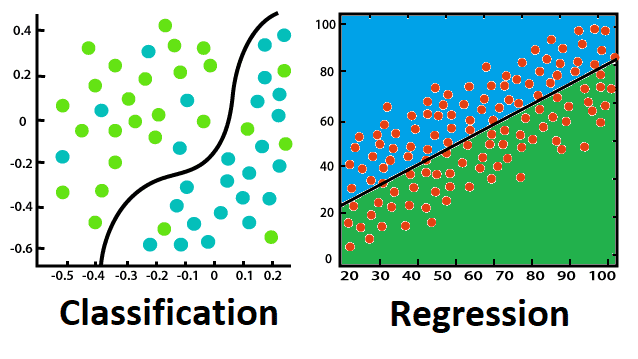Regression vs Classification in Machine Learning
In this page Regression vs Classification in Machine Learning, Types of ML Classification Algorithms, Classification Algorithms can be further divided into the following types, Types of Regression Algorithm, Difference between Regression Algorithm and Classification Algorithm.
Supervised Learning algorithms include regression and
classification techniques. Both techniques are used in Machine
Learning for prediction and work with labeled datasets. The
distinction between the two is how they're applied to various
machine learning situations.
The main difference between Regression and Classification
algorithms is that Regression algorithms are used to predict
continuous values like price, salary, age, and so on, whereas
Classification algorithms are used to predict discrete values
like Male or Female, True or False, Spam or Not Spam, and so
on.
Consider the below diagram:

Classification:
Classification is the process of identifying a function that
aids in the classification of a dataset based on several
factors. A computer program is trained on the training dataset
and then categorizes the data into distinct classes based on
that training.
The classification algorithm's goal is to identify the mapping
function that will convert the discrete input(x) to the
discrete output(y).
Example: Email Spam Detection is the finest example for
understanding the Classification challenge. The model is
trained on millions of emails on various parameters, and it
determines if an email is spam or not when it receives a new
one. The email is moved to the Spam folder if it is spam.
Types of ML Classification Algorithms:
Classification Algorithms can be further divided into the following types:
- Logistic Regression
- K-Nearest Neighbours
- Support Vector Machines
- Kernel SVM
- Naïve Bayes
- Decision Tree Classification
- Random Forest Classification
Regression:
Regression is a process of finding the relationships between
dependent and independent variables. It aids in the prediction
of continuous variables such as market trends, house values,
and so forth.
The Regression algorithm's goal is to identify the mapping
function that will translate the continuous input variable (x)
to the discrete output variable (y) (y).
For example, let's say we want to forecast the weather, so
we'll apply the Regression algorithm. When it comes to weather
prediction, the model is trained on historical data, and after
it is finished, it can accurately predict the weather for
future days.
Types of Regression Algorithm:
- Simple Linear Regression
- Multiple Linear Regression
- Polynomial Regression
- Support Vector Regression
- Decision Tree Regression
- Random Forest Regression
Difference between Regression Algorithm and Classification Algorithm
| Regression Algorithm | Classification Algorithm |
|---|---|
| The output variable in regression must be continuous or have a genuine value. | The output variable in classification must be a discrete value. |
| The regression algorithm's job is to map the continuous output variable (y) to the input value (x) (y). | The classification algorithm's job is to map the discrete output variable to the input value(x) (y). |
| Continuous data is used with regression algorithms. | With discrete data, classification algorithms are applied. |
| In regression, we strive to identify the best fit line that can more accurately predict the output. | We aim to find the decision boundary in classification to divide the dataset into various classes. |
| Weather prediction, house price prediction, and other regression problems can be solved using regression algorithms. | Classification algorithms can be used to handle problems like identifying spam emails, speech recognition, and cancer cell identification, among others. |
| Linear and non-linear regression algorithms are two types of regression algorithms. | Binary Classifier and Multi-class Classifier are two types of classification algorithms. |